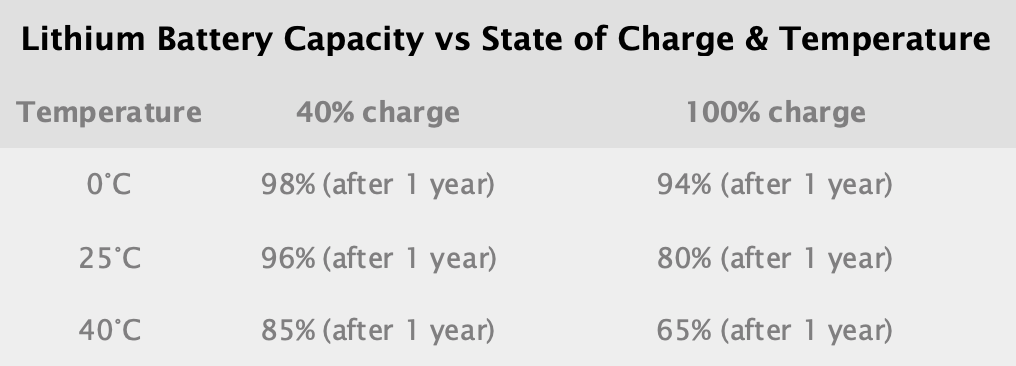SAFIERY UNIVERSITY
PROLONG LITHIUM BATTERY LIFE BY STORING AT AROUND 50% STATE OF CHARGE
This technical article is designed to give value to the reader through more knowledge on storage of Lithium batteries.


Guidelines for Storage of Lithium Batteries
Lithium batteries suffer from stress when keeping a cell at a high charge voltage.
Exposing the battery to a full state-of-charge for an extended time can be more stressful than cycling.
Table above demonstrates capacity loss as a function of temperature and SoC.
Safiery has an automated solution to this with our Lithium Storage Protection Module.
This module automatically reduces the SOC during storage to the optimum band of 40-60%.
We asked one of CSIRO’s battery experts, Dr Adam Best, to bust some myths about lithium battery care and recommend the best ways of extending lithium battery life in our electronic devices.
1. Fully charging my lithium-ion battery regularly will improve its overall life span.
Answer: False
A lithium battery is in its most “stressed” state when fully charged. It is also the most unstable state for a battery to be in so you really should try to avoid fully charging your devices as much as possible.
2. My lithium battery is at its most stable when half charged.
Answer: True.
The battery is at its most stable between 50 – 75 % charged. It’s clearly impractical in real terms for a handheld device – watching your battery charge to 50% is about as exciting as watching paint dry.
3. Allowing my lithium battery to go completely flat each cycle is good for it.
Answer: False.
This is what we in the battery industry call a “deep discharge” and it can eventually wear down your battery. Try and avoid this where you can.
4. Frequent short charging of my lithium battery should be avoided.
Answer: False.
Batteries love being topped up so this won’t cause any harm at all.
Take our battery advice to avoid having to throw your phone away.
5. Fast charging is great and won’t hurt my battery’s life.
Answer: False.
Depending on the battery’s health, charging at high rates or currents can cause heating (due to resistive effects) and lead to faster loss of battery capacity. Short top-up charging is best. Only buy fast chargers recommended by the device supplier.
Read the original Article here: https://blog.csiro.au/power-up-our-battery-advice-free-of-charge/
